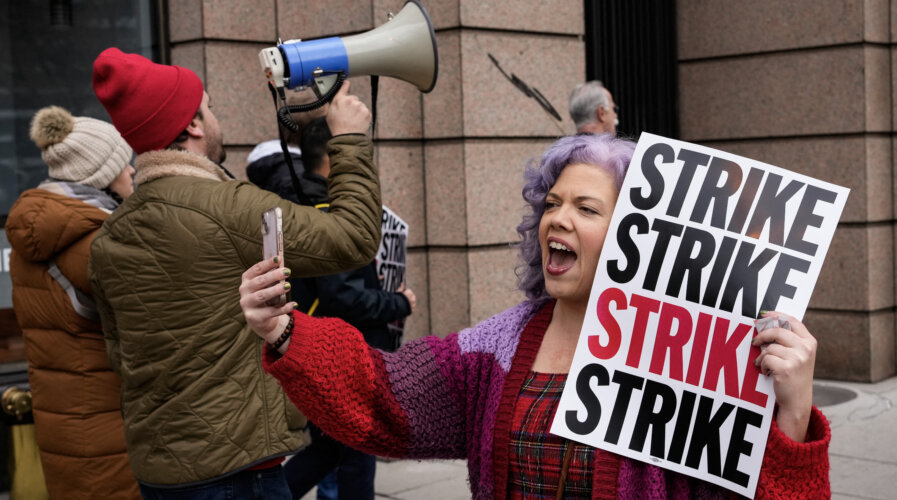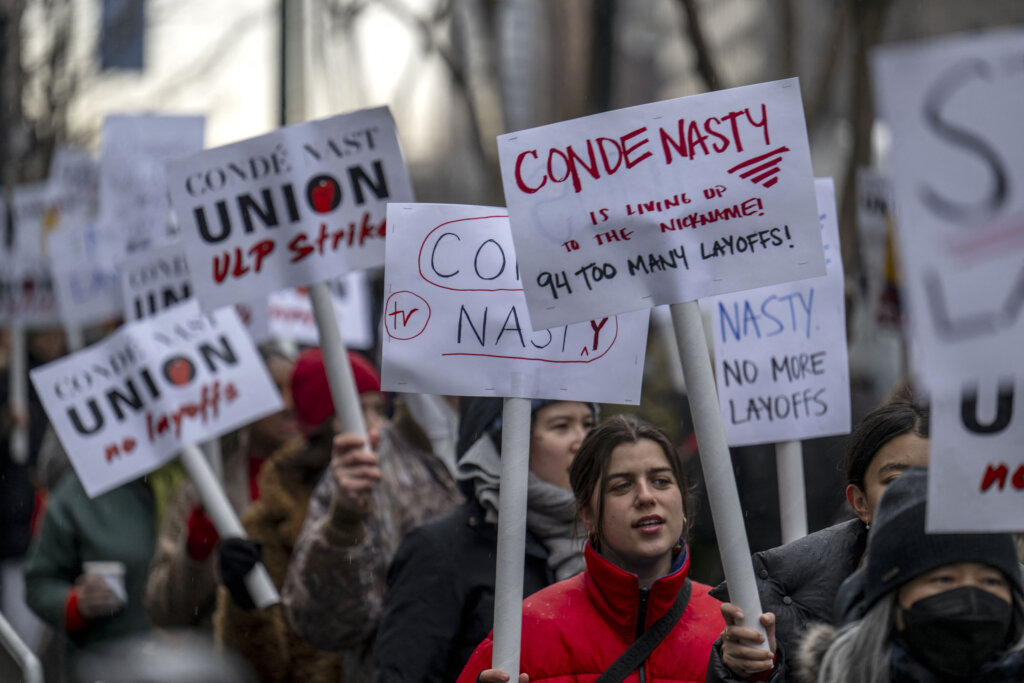
Employees of the Washington Post walk a picket line. (Photo by Drew Angerer/GETTY IMAGES NORTH AMERICA/Getty Images via AFP).
What companies should avoid during layoffs
- Companies announcing layoffs need to ensure they have a well planned strategy.
- Failure to do so could lead to the business embarrassing itself.
- It could even lose more valuable employees and customers in solidarity to the poorly-treated.
When it comes to layoffs, most companies need to have a proper plan and strategy in place to ensure the process does not lead to any untoward incidences. While many people assumed they had seen the worst of layoffs during the pandemic and in 2023, the first two months of 2024 are so far proving to be as brutal as the last few years. There is no denying that companies conduct layoffs only after trying every other possible strategy available to them.
But layoffs are sometimes inevitable for organizations of all sizes around the world. So how can a company conduct a layoff without disrupting its reputation? While some companies have been able to do it quietly, the big tech enterprises normally end up getting the most negative reactions.
There’s a logic there – from the employee’s point of view, it’s difficult to see mega-companies (in any industry) having difficulties when they have colossal resources available to them. The diferential between the company’s difficulties and the employee’s difficulties when laid off are too massive to often let the laid-off employee see the strategic necessity of their redundancy.
In Southeast Asia, e-commerce giant Lazada, which is a subsidiary of the Alibaba Group, came under heavy criticism recently on how it conducted its layoffs. According to reports, employees were left dumbfounded after realizing they were not able to schedule meetings upon returning from their year-end holidays.
Eventually, news of the layoffs broke out. Affected employees received their notifications via email. The atmosphere changed dramatically from a positive office environment to a somber scenario. There were tears, anger and confusion among employees. While many were unhappy with the terms of the layoffs such as the benefits, others were also confused about affected employees and the departments selected for layoffs.
Fortunately, several C-level executives who were also affected came together on LinkedIn to organize several events on job recruitment and how to deal with the situation. In fact, LinkedIn has become a platform for many affected employees to share their layoff journeys. Some have moved on, while others are still hoping to secure their next jobs.

Amazon employees and supporters gather during a walk-out protest against recent layoffs, a return-to-office mandate, and the company’s environmental impact, outside Amazon headquarters in Seattle, Washington, on May 31, 2023. (Photo by Jason Redmond/AFP).
It’s not personal, it’s strictly business: how companies should deal with layoffs
Tech layoffs involving big tech enterprises like AWS, Microsoft, IBM, Cisco and others often make headlines because of the high numbers of staff affected by the decision.
One recent survey found that nearly half of Americans fear that ChatGPT and other similar platforms will eventually make it harder for them to find work. The World Economic Forum estimates that over 85 million jobs could be lost to AI by 2025.
What’s more concerning is that in a survey of 213 HR professionals and 792 workers in the tech industry done by B2B Reviews, one in ten human resources leaders admitted to using ChatGPT to craft a termination letter to an employee slated for a layoff.
Given the impact that layoffs can have on an organization, here are ten actions companies need to consider when making these big decisions.
Laying off without considering the legal or ethical implications. When conducting layoffs, it is important to know all relevant laws and regulations. This includes contracts to ensure the rights and dignity of the employees are met. Failure to do so exposes companies to lawsuits, fines, or reputational damage. For example, the employees of X who were laid off filed a lawsuit with the company which was eventually settled.
Botching the announcement. Some companies announce layoffs in impersonal or insensitive ways, such as via email, phone, or video call, without giving enough notice, explanation, or feedback. This was what the stuff at Lazada in Southeast Asia recently experienced. Businesses should also avoid using ChatGPT or similar tools to generate such content.
Offering negligent or insulting severance packages. Some companies offer minimal or no severance pay, benefits, or outplacement support to laid-off employees, causing them financial hardship and emotional stress. Most countries have laws on the minimum severance amount a company needs to pay affected employees. Often, companies do offer more than this, but there are still some that only give out the minimum payments.
Laying off too many people at once. A common problem is when companies shut down entire departments and teams. By cutting too deep into their workforce, there is a sense of panic and uncertainty among the remaining employees, which can damage their reputation and brand image.
Laying off the wrong people. Some companies lay off employees based on seniority, salary, or performance metrics, without considering their actual contributions, skills, or potential, resulting in losing valuable talent, knowledge, and innovation. This is why the HR department needs to advise business leaders on how they can best go about this.
No clear strategy or vision. During the pandemic, a lot of companies went on a hiring spree. While they had a vision, the strategy did not work well. This resulted in companies that went on hiring sprees subsequently making the huge job cuts that characterized 2023 in the tech industry. Without a clear plan for how to use the resources they save or how to achieve their goals, the business often ends up in confusion, inefficiency, and missed opportunities
No proper communication or support. Emotional stress is just one of the many challenges laid-off employees experience. Businesses need to ensure they properly communicate the reasons, processes, and outcomes of the layoffs to the employees, stakeholders, and customers. Some companies can choose to provide adequate assistance or resources for the transition. This exercise will reduce anger, resentment, and stress for affected employees.

Unionized staff at Condé Nast walk the picket line during a 24-hour walk out amid layoff announcements, in front of the Condé Nast offices at One World Trade Center New York City on January 23, 2024. The strike comes after Condé Nast said it would lay off approximately 5% of its staff, some 300 employees. (Photo by ANGELA WEISS/AFP).
Failure to evaluate the alternatives. Some companies resort to layoffs without exploring other options, such as reducing costs, increasing revenue, or retraining or redeploying employees, that could help them avoid or minimize the need for layoffs.
Laying off without assessing the impact. Similar to the above, companies need to measure the effects of the layoffs on the company’s performance, culture, and morale. Soliciting feedback from the employees, customers, or partners could lead to the organization missing the opportunity to learn and improve.
No follow-ups. No organization should forget or ignore affected employees. They need to check on their wellbeing, providing references or referrals, or maintaining contact. There have been companies that went as far as offering placements and medical assistance to some employees affected by layoffs.
At the end of the day, business leaders – be it in tech or any other industry – need to realize that layoffs are not a quick way to show profits. A lot of smaller companies do this to showcase their profits. The reality is though that this is only a short-term solution. Businesses that don’t have a clear strategy when conducting layoffs could end up having more troubles in the future.
READ MORE
- 3 Steps to Successfully Automate Copilot for Microsoft 365 Implementation
- Trustworthy AI – the Promise of Enterprise-Friendly Generative Machine Learning with Dell and NVIDIA
- Strategies for Democratizing GenAI
- The criticality of endpoint management in cybersecurity and operations
- Ethical AI: The renewed importance of safeguarding data and customer privacy in Generative AI applications




